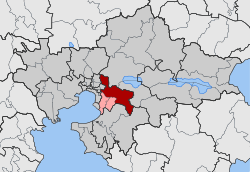Chortiatis massacre
| Chortiatis Massacre | |
|---|---|
 Chortiatis Massacre memorial | |
| Location | Chortiatis, Greece |
| Date | 2 September 1944 |
| Target | Civilians |
Attack type | Summary executions |
| Deaths | 146 |
| Perpetrators | Jagdkommando Schubert Wehrmacht |
The Chortiatis Massacre (
Background
On 28 October 1940, Italy began the
Operation Steinadler (3–13 July 1944) was the last
German occupational authorities further attempted to instill terror in the population of western Macedonia by deploying the collaborationist Poulos Verband and Jagdkommando Schubert, headed by Georgios Poulos and Friedrich Schubert respectively. These units were stationed in Krya Vrysi and Asvestochori, creating a protective axis around Thessaloniki, while Thessaloniki itself was garrisoned by the collaborationist government's Security Battalions. Schubert's previous imprisonment by the Germans, who condemned his ruthlessness and employment of former convicts during his deployment in Crete, was now disregarded, as all available forces were required for the Axis counter insurgency campaign. The pressure from the ELAS attacks around Thessaloniki threatened the ongoing German evacuation of southern Greece; Army Group E came to the conclusion that a show of force was necessary.[4]
Massacre

On 2 September, a platoon of ELAS fighters ambushed a government water supply column outside
Aftermath
The number of casualties totaled 146 people, including 109 women and 37 men ranging from the age of two months to 81 years. 34 were burned alive in the Davoudis house, 76 were killed in the bakery, 34 were shot or stabbed in their homes or outside the village. Following the destruction of Chortiatis, the Axis forces returned to their bases in Asvestochori and Thessaloniki. Fearing the return of the penal expedition and repulsed by the smell emanating from the corpses, the surviving inhabitants of Chortiatis hid in the surrounding forest. Two days later Schubert's men returned to the village to strip it of what little they had left on their previous visit. The Chortiatis massacre was not mentioned in any form in the contemporary German documents. Similarly, during course of the Nuremberg trials, then chief of staff of Army Group E Wilhelm Hammer, only referred to the ambush preceding the massacre. None of the Germans responsible for the massacre were ever convicted of their crimes. Many of them continued to advance their careers in the years that followed the war: Army Group E intelligence officer Kurt Waldheim later became the ninth President of Austria. Schubert on the other hand was arrested in the aftermath of the war, tried and executed in Athens.[6]
See also
Footnotes
- ^ Stefanidis 1992, pp. 64–95.
- ^ Dordanas 2002, pp. 677–680.
- ^ Dordanas 2002, pp. 703–710.
- ^ Dordanas 2002, pp. 708–721.
- ^ Dordanas 2002, pp. 721–727.
- ^ Dordanas 2002, pp. 728–731.
References
- Dordanas, Stratos (2002). Αντίποινα των Γερμανικών Αρχών Κατοχής στην Μακεδονία (1941–1944) [Reprisals of the German Authorities of Occupation in Macedonia (1941–1944)] (PhD thesis). Aristotle University of Thessaloniki. pp. 1–848. hdl:10442/hedi/20569. Retrieved 8 May 2016.
- Stefanidis, Yiannis (1992). "Macedonia in the 1940s". Modern and Contemporary Macedonia. 2. Athens: Papazissis: 64–103. ISBN 978-960-260-725-1. Retrieved 8 May 2016.
